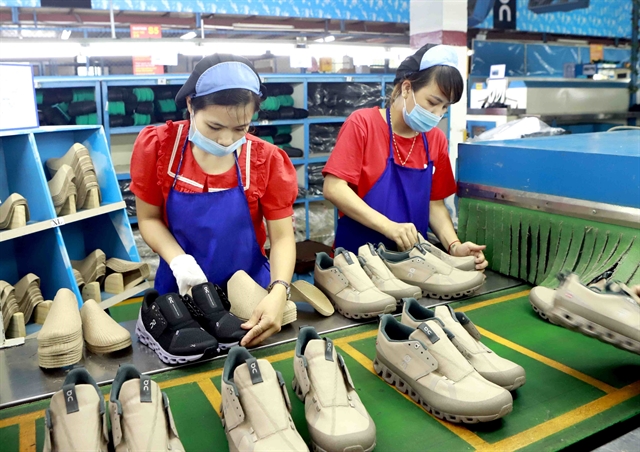 Economy
Economy

 |
| Shoes are made by workers of Phúc Yên Shoes JSC in Vĩnh Phúc Province. Footwear is among several items that would see export growth to the Canadian market. — VNA/VNS Photo Hoàng Hùng |
HÀ NỘI — Canada boasted great potential for becoming the gateway for Vietnamese businesses to expand their scale of operations as local firms seek to reach out to other markets around the world, thanks to its strength in technology, finance, customer network and logistics in the Americas, a senior trade official said.
At the same time, with the advantage of a network of free trade agreements, market advantages, high-quality labour, and trans-Asian transportation infrastructure, Việt Nam could bridge Canadian businesses with ASEAN markets, Trần Thu Quỳnh, commercial counsellor at the Việt Nam Trade Office in Canada, said.
Currently, Việt Nam is Canada's largest trading partner in ASEAN and this country's seventh largest import partner after the US, mainland China, South Korea, Japan, the Netherlands and Hong Kong.
Quỳnh told congthuong.vn that Canada considered Việt Nam an important trade partner in its strategy of diversifying trade and supply sources and enhancing the sustainability of the supply chain.
The two countries were complementary, not competitive in terms of products.
Canada had strengths in high-tech machinery, energy technology, telecommunications technology, biomedicine and input products for Việt Nam's industries such as minerals, plastics, wood, oil and gas, grains and fertiliser.
In return, Việt Nam could provide home appliances, furniture and garments to the Canadian market, thanks to preferential tariffs under the Comprehensive and Progressive Agreement for Trans-Pacific Partnership (CPTPP).
Statistics compiled by the Việt Nam Customs and the Việt Nam Trade Office in Canada indicated that Vietnamese exports to Canada dropped by 11.3 per cent to over US$5.6 billion compared to the same period last year.
This decline in exports to the North American nation could be seen as part of the general downward trend occurring during its economic recession.
It had also moved to reduce imports from most major exporting countries in ASEAN, such as Indonesia, down 7.7 per cent; Malaysia, down 18.8 per cent; and Thailand, down 10.9 per cent.
Two leading product groups that accounted for the largest proportion of Vietnamese export turnover to Canada included electronics and mobile phones, up 9.8 per cent, and boiler reactors, up 57.3 per cent.
Meanwhile, Canada exported goods worth $620 million to the Vietnamese market last year, down 12.7 per cent on-year.
Despite differences recorded in data between the two countries’ agencies, the country ran a large trade surplus of $8.5 billion with Canada in 2023.
According to the office, Vietnamese items that would see good export growth included footwear, leather products and hats.
Meanwhile, the export growth of input materials for production such as rubber, iron and steel, plastic materials and chemicals would depend on the recovery speed of orders and growth in Canadian industrial production. Exports of these staples experienced a sharp decline in 2023.
Quỳnh said this year her office would continue to implement activities to promote the supply chain and logistics connections between Việt Nam and Canada, helping businesses from both sides better understand the CPTPP and how to take advantage of this agreement in their business investment strategies.
At the same time, the office would focus on facilitating exports of Vietnamese firms, especially for small and medium-sized enterprises, and organising delegations of Canadian firms to come to Việt Nam to seek business opportunities, including a delegation of over 100 businesses to Việt Nam in March and another in the textile and garment sector to attend the upcoming Việt Nam Sourcing Fair in June.
In addition, it would also concentrate on supporting Vietnamese micro and small food producers to participate in trade fairs in Canada while promoting their cooperation with overseas Vietnamese businesses. — VNS




